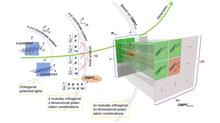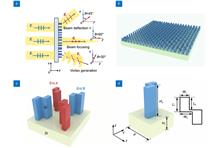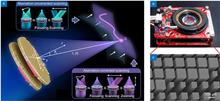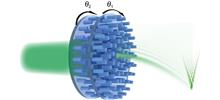 View fulltext
View fulltext
Orthogonal matrices have become a vital means for coding and signal processing owing to their unique distributional properties. Although orthogonal matrices based on amplitude or phase combinations have been extensively explored, the orthogonal matrix of polarization combinations (OMPC) is a novel, relatively unexplored concept. Herein, we propose a method for constructing OMPCs of any dimension encompassing 4n (where n is 1, 2, 4, 8, …) mutually orthogonal 2n-component polarization combinations. In the field of holography, the integration of polarization multiplexing techniques with polarization-sensitive materials is expected to emerge as a groundbreaking approach for multichannel hologram multiplexing, offering considerable enhancements in data storage capacity and security. A multidimensional OMPC enables the realization of multichannel multiplexing and dynamical modulation of information in polarization holographic recording. Despite consolidating all information into a single position within the material, we effectively avoided extraneous crosstalk during the reconstruction process. Our results show that achieving four distinct holographic images individually and simultaneously depends on the polarization combination represented by the incident wave. This discovery opens up a new avenue for achieving highly holographic information storage and dynamically displayed information, harnessing the potential of OMPC to expand the heretofore limited dimensionality of orthogonal polarization.
In lightweight augmented reality (AR) glasses, the light engines must be very compact while keeping a high optical efficiency to enable longtime comfortable wearing and high ambient contrast ratio. “Liquid-crystal-on-silicon (LCoS) or micro-LED, who wins?” is recently a heated debate question. Conventional LCoS system is facing tremendous challenges due to its bulky illumination systems; it often incorporates a bulky polarizing beam splitter (PBS) cube. To minimize the formfactor of an LCoS system, here we demonstrate an ultracompact illumination system consisting of an in-coupling prism, and a light guide plate with multiple parallelepiped extraction prisms. The overall module volume including the illumination optics and an LCoS panel (4.4-μm pixel pitch and 1024x1024 resolution elements), but excluding the projection optics, is merely 0.25 cc (cm3). Yet, our system exhibits an excellent illuminance uniformity and an impressive optical efficiency (36%–41% for a polarized input light). Such an ultracompact and high-efficiency LCoS illumination system is expected to revolutionize the next-generation AR glasses.
Dielectric chiral metasurface is a new type of planar and efficient chiral optical device that shows strong circular dichroism or optical activity, which has important application potential in optical sensing and display. However, the two types of chiral optical responses in conventional chiral metasurfaces are often interdependent, as their modulation of the amplitudes and phases of orthogonal circularly polarized components is correlated, which limits the further progress of chiral meta-devices. Here we propose a new scheme for independently designing the circular dichroism and optical activity of chiral metasurfaces to further control the polarization and wavefront of transmitted waves. Inspired by mixtures of chiral molecular isomers, we use the dielectric isomer resonators to form “super-units” instead of single meta-atoms for chiral responses in terahertz band, which is called racemic metasurface. By introducing two levels of Pancharatnam-Berry phases between meta-atoms and “super-units”, the polarization rotation angle and wavefront of the beam can be designed without the far-field circular dichroism. We demonstrate the strong control ability on terahertz waves of this scheme through simulation and experiments. In addition, this new type of device with near-field chirality but no far-field circular dichroism may also have important value in optical sensing and other technologies.
Scanning focused light with corrected aberrations holds great importance in high-precision optical systems. However, conventional optical systems, relying on additional dynamical correctors to eliminate scanning aberrations, inevitably result in undesired bulkiness and complexity. In this paper, we propose achieving adaptive aberration corrections coordinated with focus scanning by rotating only two cascaded transmissive metasurfaces. Each metasurface is carefully designed by searching for optimal phase-profile parameters of three coherently worked phase functions, allowing flexible control of both the longitudinal and lateral focal position to scan on any custom-designed curved surfaces. As proof-of-concept, we engineer and fabricate two all-silicon terahertz meta-devices capable of scanning the focal spot with adaptively corrected aberrations. Experimental results demonstrate that the first one dynamically scans the focal spot on a planar surface, achieving an average scanning aberration of 1.18% within the scanning range of ±30°. Meanwhile, the second meta-device scans two focal points on a planar surface and a conical surface with 2.5% and 4.6% scanning aberrations, respectively. Our work pioneers a breakthrough pathway enabling the development of high-precision yet compact optical devices across various practical domains.
Dynamic control of Airy beam has been attracting scientists’ attention due to its potential applications in imaging, optical manipulation and laser manufacturing. However, traditional way of dynamic tuning of free space Airy beam usually requires bulky optics and will inevitably limit its practical applications. To solve this issue, a recent work proposes to use a compact meta-device which consists of two cascaded dielectric metasurfaces working in the visible regime.













